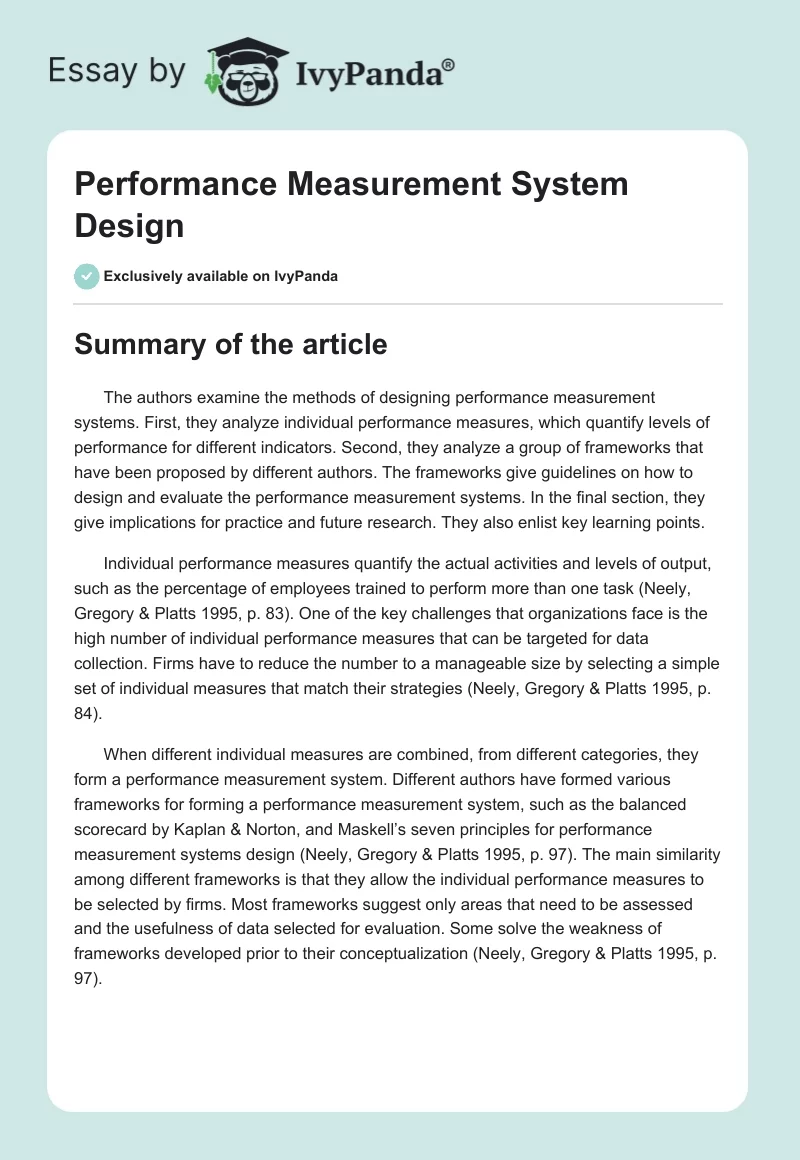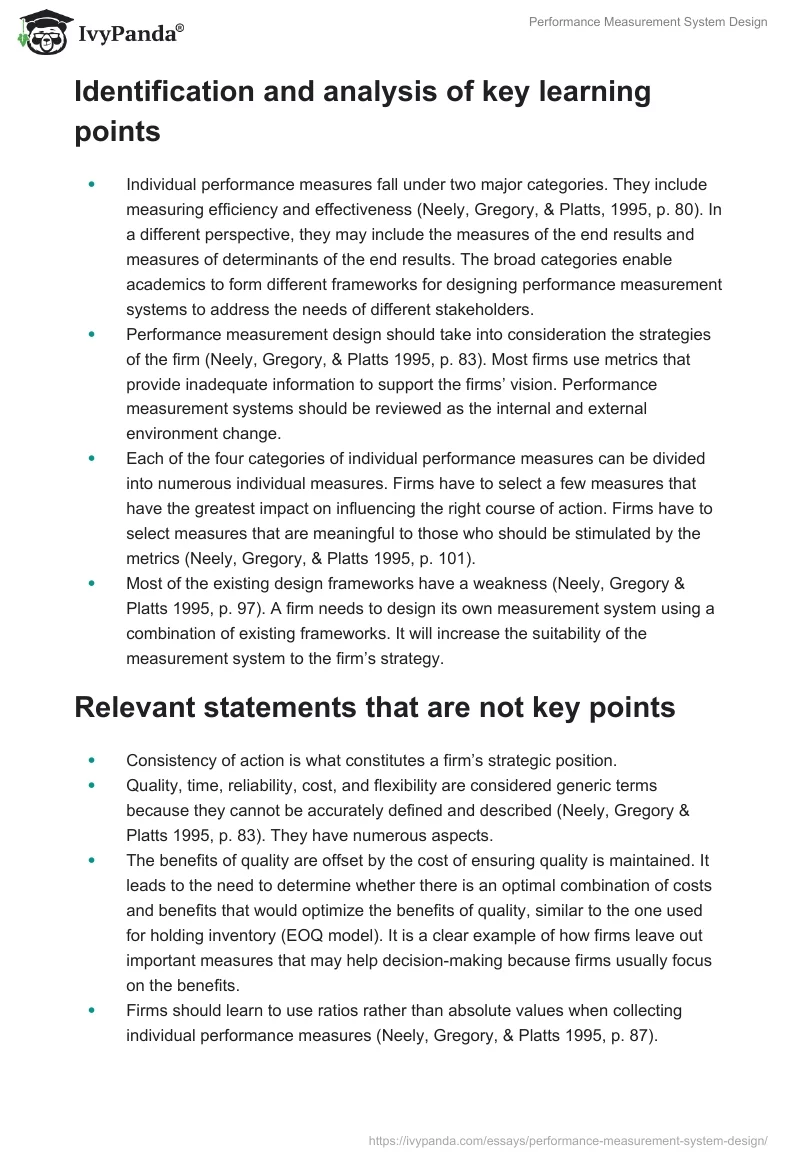Summary of the article
The authors examine the methods of designing performance measurement systems. First, they analyze individual performance measures, which quantify levels of performance for different indicators. Second, they analyze a group of frameworks that have been proposed by different authors. The frameworks give guidelines on how to design and evaluate the performance measurement systems. In the final section, they give implications for practice and future research. They also enlist key learning points.
Individual performance measures quantify the actual activities and levels of output, such as the percentage of employees trained to perform more than one task (Neely, Gregory & Platts 1995, p. 83). One of the key challenges that organizations face is the high number of individual performance measures that can be targeted for data collection. Firms have to reduce the number to a manageable size by selecting a simple set of individual measures that match their strategies (Neely, Gregory & Platts 1995, p. 84).
When different individual measures are combined, from different categories, they form a performance measurement system. Different authors have formed various frameworks for forming a performance measurement system, such as the balanced scorecard by Kaplan & Norton, and Maskell’s seven principles for performance measurement systems design (Neely, Gregory & Platts 1995, p. 97). The main similarity among different frameworks is that they allow the individual performance measures to be selected by firms. Most frameworks suggest only areas that need to be assessed and the usefulness of data selected for evaluation. Some solve the weakness of frameworks developed prior to their conceptualization (Neely, Gregory & Platts 1995, p. 97).
Identification and analysis of key learning points
- Individual performance measures fall under two major categories. They include measuring efficiency and effectiveness (Neely, Gregory, & Platts, 1995, p. 80). In a different perspective, they may include the measures of the end results and measures of determinants of the end results. The broad categories enable academics to form different frameworks for designing performance measurement systems to address the needs of different stakeholders.
- Performance measurement design should take into consideration the strategies of the firm (Neely, Gregory, & Platts 1995, p. 83). Most firms use metrics that provide inadequate information to support the firms’ vision. Performance measurement systems should be reviewed as the internal and external environment change.
- Each of the four categories of individual performance measures can be divided into numerous individual measures. Firms have to select a few measures that have the greatest impact on influencing the right course of action. Firms have to select measures that are meaningful to those who should be stimulated by the metrics (Neely, Gregory, & Platts 1995, p. 101).
- Most of the existing design frameworks have a weakness (Neely, Gregory & Platts 1995, p. 97). A firm needs to design its own measurement system using a combination of existing frameworks. It will increase the suitability of the measurement system to the firm’s strategy.
Relevant statements that are not key points
- Consistency of action is what constitutes a firm’s strategic position.
- Quality, time, reliability, cost, and flexibility are considered generic terms because they cannot be accurately defined and described (Neely, Gregory & Platts 1995, p. 83). They have numerous aspects.
- The benefits of quality are offset by the cost of ensuring quality is maintained. It leads to the need to determine whether there is an optimal combination of costs and benefits that would optimize the benefits of quality, similar to the one used for holding inventory (EOQ model). It is a clear example of how firms leave out important measures that may help decision-making because firms usually focus on the benefits.
- Firms should learn to use ratios rather than absolute values when collecting individual performance measures (Neely, Gregory, & Platts 1995, p. 87).
- Firms should seek to measure total productivity relative to other factors in order to increase the cohesiveness of actions taken by different teams (Neely, Gregory, & Platts 1995, p. 92).
Analysis of ideas and concepts
One of the key points is that organizations should develop a performance measurement system that supports their strategy. The purpose of collecting data is to trigger some corrective action towards goals that have not been met (Neely, Gregory, & Platts 1995, p. 94). When goals are achieved, new goals are set. In relation to this point and in practice, the authors suggest that Japanese firms collect metrics that can be aligned with their strategy when firms in Western countries fail to put the theoretical framework into practice.
The difference may be upheld when one considers only long-term goals. Japanese firms and Western countries’ firms have aligned themselves with different goals. Managers in Western countries focused on financial performance. They selected metrics that would trigger better financial performance, especially higher profit margins and higher prices in the stock market. Japanese firms understood that financial performance would improve when the firm targets to improve production performance. They collected metrics to improve production effectiveness and efficiency. The key learning point is that firms should learn to evaluate the systemic impacts of their consistent actions. They should choose to collect data on individual measures that have a sustainable impact on efficiency and effectiveness.
Some managers choose metrics that focus only on short-term goals. The authors highlight a case where managers fail to invest in innovation to avoid creating a bad picture of their financial performance in the short-run (Neely, Gregory, & Platts 1995, p. 102). In the long run, the firm fails to have positive results in innovation when it had displayed an attractive financial performance in the short run. A key lesson is that firms should learn to include metrics that cover both the long-term and short-term goals when designing performance measurement systems.
Some key metrics may not be accessible because of confidentiality reasons. In competitive benchmarking, the authors highlight the challenge of obtaining data that can allow direct comparison of individual measures of performance (Neely, Gregory, & Platts 1995, p. 104). A direct comparison would allow firms to easily find areas that are lagging instead of relying on overall financial performance. Firms have to rely on technical publications that compare large firms. In 2012, an article ranked Apple at the top of the list in the rate of innovation, spending 2.2% of its revenues on R&D in 2011. Google occupied the second position, spending 13.6% on R&D in 2011 (Jaruzelski, Loehr, & Holman 2012, p. 11). The information shows that relatively higher expenditure on R&D does not translate into a higher rate of innovation. The information can be used for benchmarking the effectiveness of R&D expenditure.
The main weakness of the information is that it is based on the opinion of senior managers and analysts rather than the actual number of new products delivered to the market in the period under consideration. Another weakness is that the information may be outdated. Neely, Gregory, & Platts (1995, p. 106) explain that some information used in benchmarking are developed by analysts rather than the actual collection of data. A key lesson at this point is that the firm should assess other methods for benchmarking, such as functional benchmarking.
My opinion about the ideas
I agree with most of the ideas that are presented in the article. One of the reasons for agreeing with the authors is that they have presented their argument in a manner that builds from smaller and simpler parts to more complex theories. For example, in the case of individual performance measures, they show using ‘quality’ that it has very many measurable aspects (Neely, Gregory, & Platts 1995, p. 83).
In the case of ‘flexibility’, they show that it can be described in many different ways, depending on the targeted area of operations. When they explain that firms have to select individual measures that match their strategy, it becomes easily visible. It is possible that firms may design performance measurement systems that target short-term goals, which may make them select performance measures that do not align with the firms’ strategy. The authors build from individual performance measures to the collective system. The authors compare different frameworks, showing similarities and differences.
Reflection on the practical implications
Most of the ideas can be applied to the routine activities of a firm, considering that a firm that uses an effective performance measurement system does not have to wait for the annual and quarterly financial statements. Kennerly & Neely (2003, p. 213) highlight that some firms have resolved to consider changes in the business environment when reviewing performance measurement systems. It has occurred in response to research studies. Aligning the designing process to the firm’s strategy is one of the concepts that can be practised for sustainable profitability. For example, a firm that seeks to grow through innovation has to include individual performance measures in its performance measurement system. It has to use ratios in its metrics. It has to use benchmarking to ensure that it does not overspend on and underperform in innovation. Another important point is that the reward system should encourage cohesiveness in pursuing the firm’s strategy. The article has many points that can be applied in practice.
List of references
Jaruzelski, B, Loehr, J & Holman, R 2012, ‘The global innovation 1000: Making Ideas Work’, Strategy+Business Magazine. Web.
Kennerly, M & Neely, A 2003, ‘Measuring performance in a changing business environment’, International Journal of Operations & Production Management, vol. 23, no. 2, pp. 213-229. Web.
Neely, A, Gregory, M & Platts, K 1995, ‘Performance measurement system design: A literature review and research agenda’, International Journal of Operations & Production Management, vol. 15, no. 4, pp. 80-116. Web.


